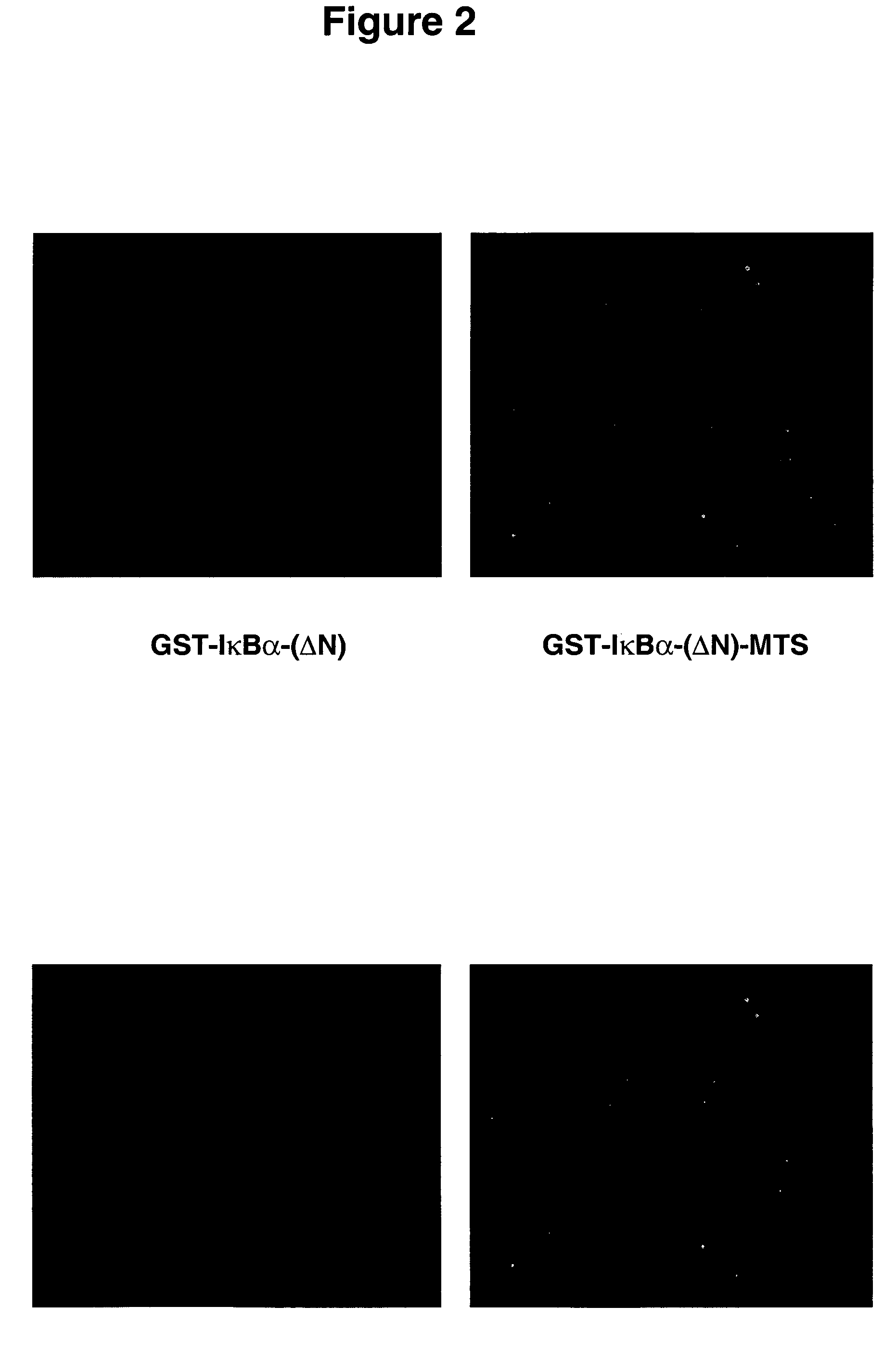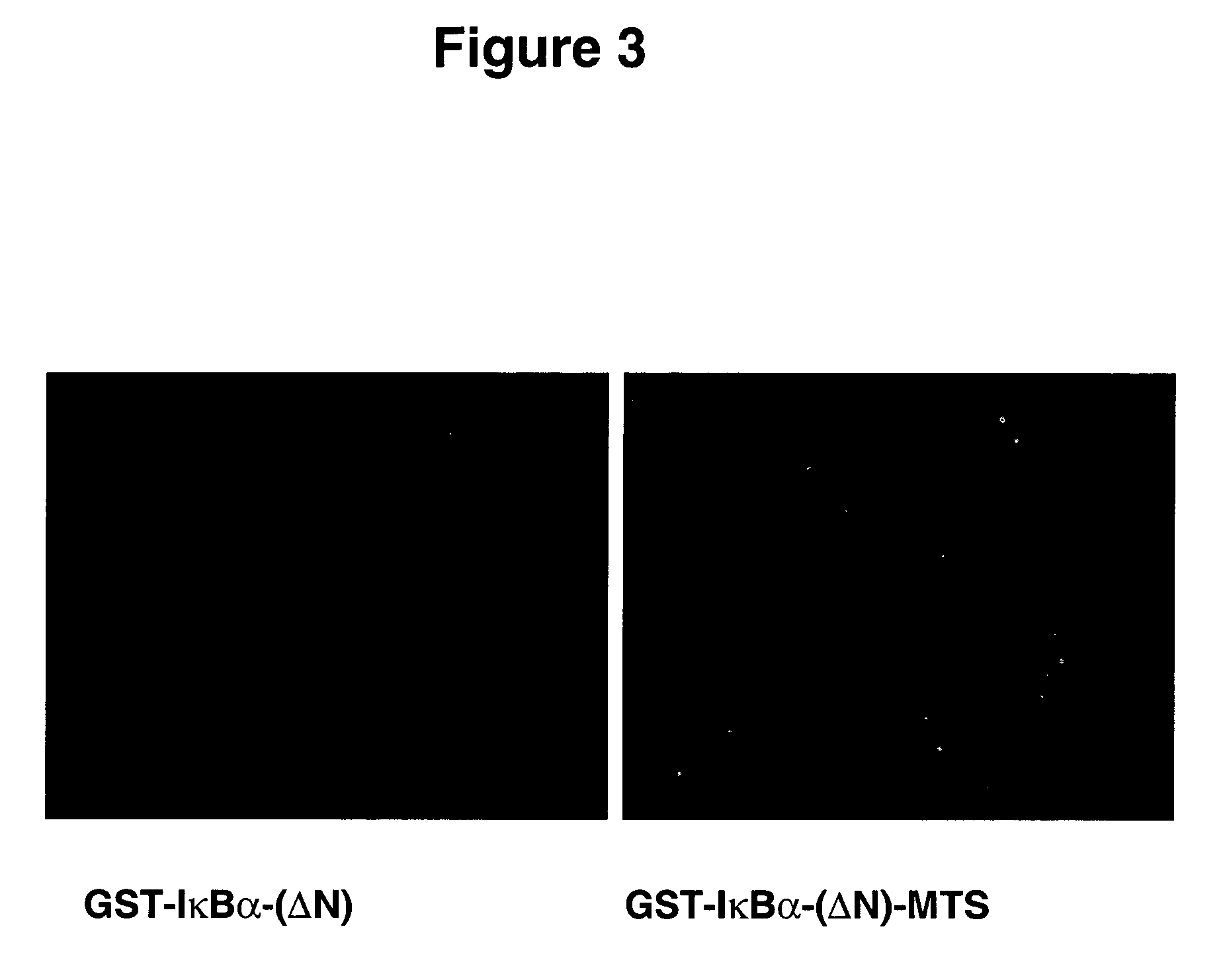Fusion proteins with a membrane translocating sequence and methods of using same to inhibit an immune response
a technology of membrane translocation and fusion proteins, which is applied in the field of fusion proteins with membrane translocation potential, can solve the problems of limited clinical utility of transgenes and unaddressed needs in the ar
- Summary
- Abstract
- Description
- Claims
- Application Information
AI Technical Summary
Benefits of technology
Problems solved by technology
Method used
Image
Examples
example 1
Construction and Purification of IκBα-(ΔN)-Membrane Translocating Sequence Protein
[0123] An IκBα molecule was created by deletion of the amino terminal portion of the protein using the RT-PCR technique with RNA obtained from Jurkat T cells. To produce the fusion protein cDNA of IκBα-(ΔN) was cloned into an MTS vector that allows expression of the fusion protein tagged with GST on the N+ terminus of the protein and the MTS motif on the carboxyl terminus. Protein expression was induced by the addition of isopropyl β-D thiogalactoside (IPTG) to the culture.
[0124] cDNA from Jurkat T cells was used as a template to amplify specific cDNA of IκBα (Haskill et al., 1991). Each of the primers contained a BamHI site at the 5′-end. The sequence of the primers was:
(SEQ ID NO. 10)5′-CCGGATCCCCATGAAAGACGAGGAGTACGAGCAGATGGTCand(SEQ ID NO. 11)5′-CCGGATCCCTAACGTCAGACGCTGGCCTCCAAACACACA.
[0125] These primers encode a cDNA for NH2 terminal truncated form (amino acid 37-317) of IκBα. The PCR product ...
example 2
Delivery of IκBα-(ΔN)-MTS Into Living Cells
[0129] To confirm the uptake of the recombinant protein, mammalian NIH3T3 fibroblast cells were used. Subconfluent NIH3T3 cells were incubated for 1 h with different concentrations of the wild type and cell permeable IκBα-(ΔN). Cells were fixed and protein was detected using an anti-GST antibody and a secondary antibody coupled to Texas red fluorochrome. Briefly, NIH3T3 cells were cultured in 4 well slides (Nunc, Calif.) and grown for 3 days at 37° C. Sub-confluent cells were washed with media without sera and incubated with the different proteins at a concentration of 90 μg / ml for 1 h at 37° C. The cells were washed with cold PBS and fixed with 3.7% paraformaldehyde in PBS at 37° C. for 15 min. Cells were washed again 3 times with PBS, and treated with 0.25% Triton X-100 in PBS for 10 min. Then, cells were incubated with blocking solution (PBS+1% normal goat serum (Sigma, Mo.)+1% BSA (Sigma, Mo.)) for 30 min at 37° C. and 5% CO2. After bl...
example 3
Inhibition of NF-κB Activity In Living Cells
[0131] The IκBα-(ΔN) molecule lacks the sequences required for signal-dependent degradation and it has been show in in vivo systems to be a constitutive repressor of multiple NF-κB / Rel proteins (Brockman et al., 1995; Boothby et al., 1997; Mora et al., 1999; Mora et al., 2001a; Mora et al., 2001b). In the absence of phosphorylation sites, IκBα protein is resistant to degradation but maintains the ability to interact with latent NF-κB / Rel complexes in the cytoplasm inducing permanent retention of NF-κB dimers in the cytoplasm.
[0132] To determine whether IκBα-(ΔN)-MTS inhibits endogenous NF-κB / Rel signaling pathway in vivo, mobility shift analyses in primary thymocytes were performed. Cell preparations were incubated for 1 h with the wild type and permeable recombinant proteins, followed by treatment with PMA / ionomycin. Chemical activation by PMA and ionomycin has been shown to mimic activation through the TCR-associated nuclear translocat...
PUM
| Property | Measurement | Unit |
|---|---|---|
| aerodynamic diameter | aaaaa | aaaaa |
| aerodynamic diameter | aaaaa | aaaaa |
| weight | aaaaa | aaaaa |
Abstract
Description
Claims
Application Information
 Login to View More
Login to View More - R&D
- Intellectual Property
- Life Sciences
- Materials
- Tech Scout
- Unparalleled Data Quality
- Higher Quality Content
- 60% Fewer Hallucinations
Browse by: Latest US Patents, China's latest patents, Technical Efficacy Thesaurus, Application Domain, Technology Topic, Popular Technical Reports.
© 2025 PatSnap. All rights reserved.Legal|Privacy policy|Modern Slavery Act Transparency Statement|Sitemap|About US| Contact US: help@patsnap.com



